Friends of the JC Raulston Arboretum Newsletter
Fall 2022 – Vol. 25, No. 2
Director's Letter

Greetings from the JC Raulston Arboretum
By Mark Weathington, Director
Plants want to live. That’s what I’ve learned in 25 years of working in horticulture professionally. Spring and fall are packed to the gills for me and I never have enough time or daylight to really garden as much as I’d like so summer and winter is when my home garden gets most of the attention. In fact, my mid-August weekends this year were spent digging 100+ different plants out of one of my garden beds and transplanting them elsewhere so I could make some design changes to the landscape. I’m relying on these plants wanting to live!
I love making changes in the garden, at home and here at the JCRA. We’ve already started making some changes including adding a full-time nursery & research technician. Sophia’s main job is to produce plants for our collections, to distribute to other gardens and researchers, and of course to get plants out to you, our members and the general public. We are already seeing healthier and more robust plants now that we have someone who can really take the time needed to care for them.
Expect to continue to see more changes as we add staff to support the team already in place. It’s been said that gardening is the slowest of the performing arts but I’ve never felt a staff so excited to grow and expand and re-think how, what, and why we do what we do—and we don’t want to wait. The possibilities to follow our mission in new and exciting ways to bring our passion and plants to an ever wider audience has all of us planning—and planting for a better world.
See you in the garden.
Horticulture
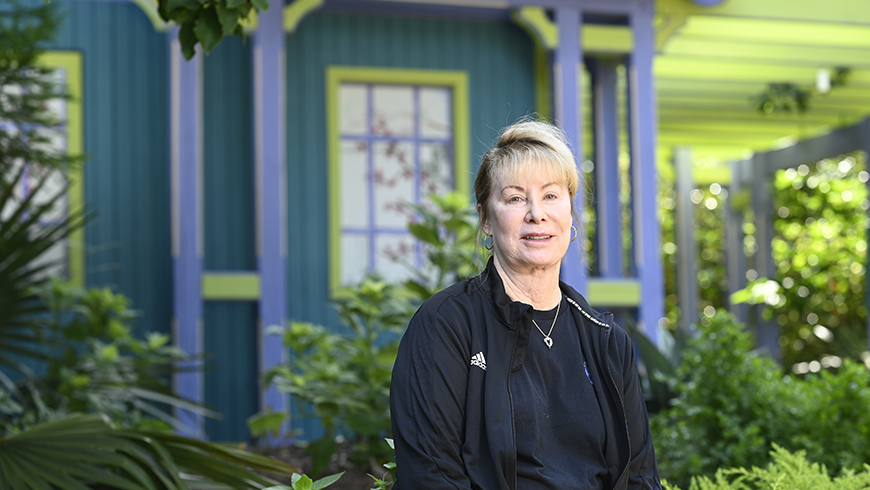
When Nature Calls…Updates Coming to the Necessary
By Amy Beitzel, Development Assistant
A beloved landmark at the JC Raulston Arboretum is scheduled to receive essential updates thanks to a generous gift from Carol McNeel (pictured above). "The Necessary at McNeel Corner" as it will be known will feature several improvement projects to make it more accessible, sustainable, and even more welcoming to the thousands of visitors who explore the Arboretum each year.
Carol McNeel, a philanthropist and expert gardener, has served as a board member at the Arboretum since 2020. She and her husband Rick believe in the healing powers of gardening and green spaces, a mission that closely aligns with the Arboretum’s goal to foster interest in diverse plants for bettering communities.
"I’m a quirky person, and everything I do is kind of eclectic, once I found out that this little blue building was the restroom and needed a spruce, I knew it was for me."
The distinctive restroom structure topped with the JCRA’s signature maple leaf started life as a student construction project for a flower show before being moved to the Arboretum as the focal point for the north end of the Main Border. The building draws frequent visitors not only for practical needs but also because the whimsical features make a great backdrop for photo opportunities.
The generous gift will improve the experience of the thousands of visitors who explore the diverse collection of plants on display at the Arboretum. Planned projects include:
- Expanding the restroom facilities and making them more sustainable
- Installing a new water fountain with a bottle refill station under the pergola
- Structural repairs to the roof shingles and arbor
- The accessible entrance will be made more welcoming
- The southside garden will be replanted
"The Arboretum is so welcoming. Everyone there is so knowledgeable, down to earth and so much fun," says McNeel. "I love wandering the whole place. It’s just beautiful and sometimes I look at their plant list and have no idea how they get it all in there. I’m thrilled to support them."
Story originally published by the College of Agriculture and Life Sciences, written by Alice Manning Touchette.
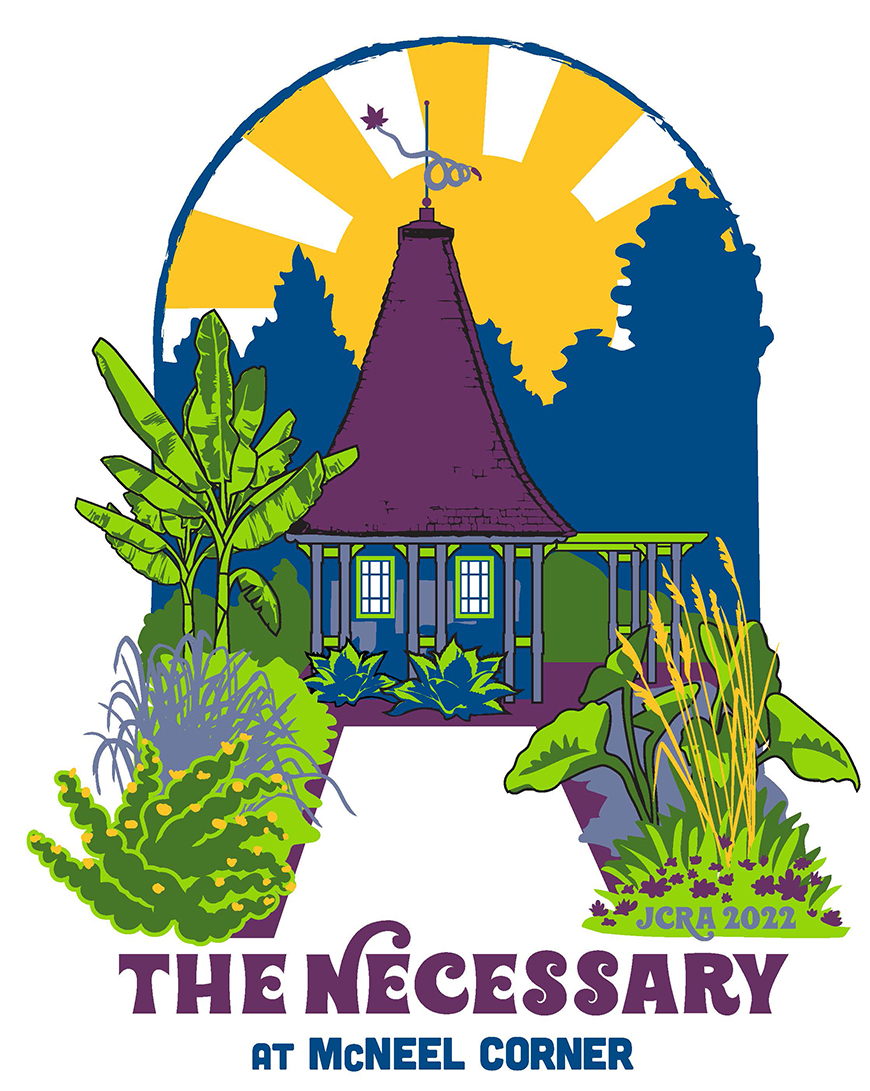
"The Necessary at McNeel Corner" is featured on the 2022 Arboretum T-shirt design. We took a groovy approach to illustrate this popular Arboretum icon. Sales from the shirts help support Arboretum programs and operations. We hope you love it as much as we do. T-shirts are $20 each and are available for sale at the McSwain Education Center and Visitor Center.
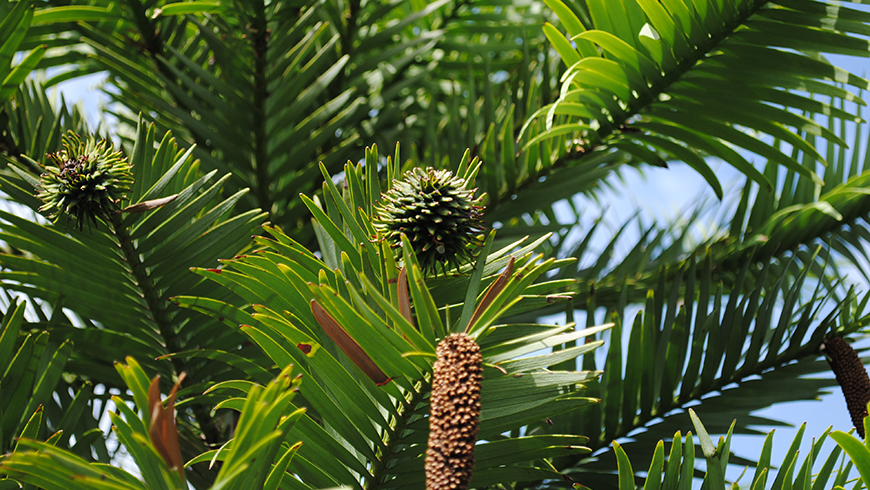
Shaking Things Up Down Under
By Mark Weathington, Director
About a year or so ago I was approached about writing a chapter for a textbook to be titled "Botanical Gardens and Their Role in Plant Conservation." Because of a deep-rooted character flaw which makes saying, "No," a near impossibility, I of course agreed to write a chapter (wrangling in Tony Avent of Juniper Level Botanic Garden/Plant Delights Nursery as a co-author) so long as I could write about conservation through propagation and dissemination. There was quite a bit of hesitancy and debate from the editors and publishers about this idea as most conservation programs take it as a given that rare and endangered plants should be kept protected under their watchful eyes and not allowed into the hands of the hoi polloi.
Ultimately, after much consternation and hand-wringing, the editors decided to allow the JCRA’s heretical ideas into the textbook. They probably began regretting our inclusion when the 3rd manuscript deadline passed and they certainly did by the 4th or 5th. Writing the text was an interesting exercise for me and helped galvanize the idea as I read about one instance after another where the dissemination of endangered material helped conserve the genetics and protect the vulnerable plants in the wild.
As our introductory abstract says in part:
The inherent limits to in situ conservation due to anthropogenic factors such as rapid urbanization and human-induced climate change and the constraints of ex situ conservation for many plants due to the resource constraints of botanical institutions require novel approaches to preserve the world’s flora. Removing barriers to access and inviting commercial entities and specialist groups to assist in the propagation and dissemination of ethically and legally collected plant material along with its provenance information is one way we can increase the genetic diversity being stored in ex situ sites. Propagation and commercialization of threatened and rare plants by ethical entities in cooperation with botanical and conservation organizations provides access to enthusiasts and collectors which reduces or eliminates collecting pressures on wild populations. *
* I will be happy to share the full chapter with anyone who wasn’t put to sleep by the abstract. – MW
A year-long, deep dive into the topic brought me back to the 5th Global Botanic Garden Congress (GBGC) in New Zealand where the limits of what botanic gardens can achieve were discussed with sad regularity. When I was approached to speak again, this time at the 7th iteration of the GBGC in Australia, I unfortunately had to bow out due to prior commitments and funding priorities. I will provide an article for the official Proceedings to be published after the event however and continue to raise the issue with my colleagues around the globe. The JCRA will have a bit of representation as our former graduate student Rebecca Turk, now director of public engagement at Huntsville Botanic Garden, will be speaking at the event. They grow up so fast.
Australia makes an interesting backdrop for the topic as one of the great success stories of an endangered plant being brought to market in a coordinated and collaborative way is the famed Wollemia nobilis. The Wollemi pine was only discovered in 1994 in New South Wales. A program was developed to propagate and distribute this rarity through botanic gardens and specialty nurseries, including my co-author’s Plant Delights Nursery, rather than restrict it to the gate-keeping tendencies many conservationists seem to prefer.
I look forward to sharing my perspectives, with plenty of published research to back those views, with my colleagues. Based on my previous experiences it should provide some lively debate especially around the topic of benefit sharing, a poorly defined and nebulous concept that groups and individuals who see the nursery industry as the enemy simply do not understand. The route from a wild collected plant making it to market in any meaningful way is typically a long and tortuous process. The beginning of the story of the popular ENCORE series of azaleas began in part with the collection of seed in Taiwan in 1968, nearly 30 years before the first re-blooming azaleas were released, making profit sharing with the originating country difficult at best.
The JCRA is regularly invited to participate on the national and international stage as a trusted and respected entity. We often present a different perspective than other gardens due in large part to our legacy built on supporting the nursery and landscape industry, the desire to diversify the cultivated landscape, as well as our flat rejection of either/or and black/white thinking. Solutions usually involve navigating in the real world of gray areas rather than the absolutes of theoretical thinking. These scientific based conferences generally do not offer travel reimbursements or speaker honoraria and the costs associated with traveling to the far side of the globe represents significant investment on the part of the Arboretum. We feel it is important to share our mission and inspire both our colleagues and our constituents on a large stage like the GBGC but also must weigh all of the Arboretum’s priorities and commitments before accepting every invitation.
If you are interested in supporting the JC Raulston Arboretum’s regional, national, and international outreach efforts please contact our director of development, Alycia Thornton at (919) 513-7068 or alycia_thornton@ncsu.edu, so we can continue to be unconventional with conventional wisdom and shake up unexamined ideas from Raleigh to Melbourne.
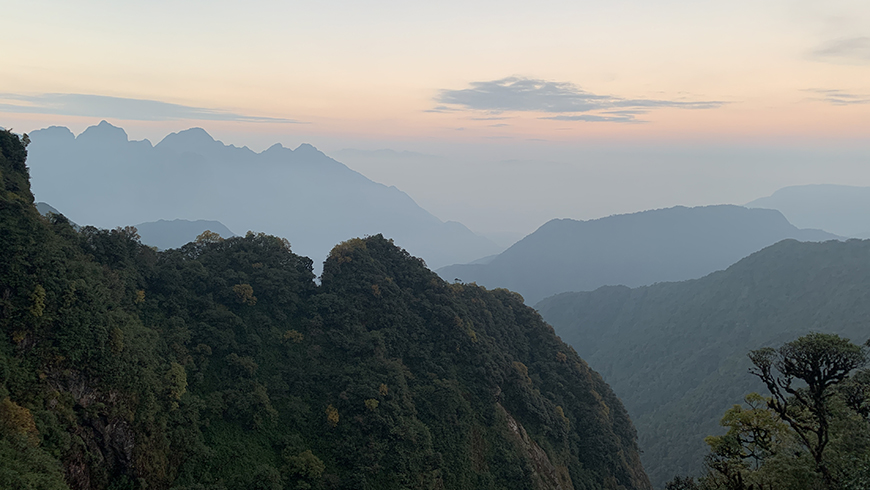
Good Morning Vietnam!
By Mark Weathington, Director
It feels like a lifetime since I’ve been able to indulge in one of the great joys of my career in horticulture—heading out to the remote spots of the world to study, document, and collect plants for research, trial, breeding, and conservation purposes. My 2019 expedition to southern China’s Jinggangshan and Sanquinshan mountains seems like ages ago and the older I get, the more I realize how fleeting these experiences will be. Plans for 2020 were made and canceled, 2021’s fared much the same but finally (while furiously knocking on wood) October 2022 once again saw me on the road in Asia.
Of all the canceled travel plans, the one that pained me the most was a spring 2020 expedition to Vietnam. Not only would it be my first visit to a country that has had such a huge impact on the culture and psyche of ours, but it also meant the postponement of a visit to see a newly (2018) described species. With the world once more opening up, Scott McMahan, manager of the International Plant Exploration Program at Atlanta Botanic Garden and his assistant Tim Marchlik, Dan Hinkley of Windcliff Gardens, and I set out to see this plant for ourselves.
Few plants have hit the market with as much force as Loropetalum chinense (Chinese fringe flower) in the last several decades, helped in part by J. C. Raulston’s enthusiasm for it. The purple-leafed, pink flowered varieties have been especially popular, some might even say to the point of overuse so just imagine the excitement that a bright yellow flowered species might bring to the market along with some incredible breeding opportunities. Since the early 1900’s only three species of the witchhazel related genus Loropetalum had been discovered but in April of 2018 a group of botanists from Vietnam and Russia discovered a yellow flowering species which was formally named and described as Loropetalum flavum. The plant grows on the dense, almost marble-like limestone of the extremely steep ridges of northern Ha Giang province along the Chinese border.
L. flavum differs from the much more widespread L. chinense in several ways beyond flower color. Plants are much more tree-like in growth with leathery, narrow, evergreen leaves up to five inches long. The strappy petalled flowers are about the same size as wild L. chinense but are held in dense heads along the stems. Winter hardiness has been somewhat variable for plants from this and similar regions but the high elevation gives hope and the related Disanthus ovatifolius, also newly described from the region, has been settling in well at the JCRA.

Of course, there is never any guarantee of finding a needle in the haystack that is the southern Asian mountain ranges. A magnificent rare specimen may be just on the far side of a ridge or growing right over your head while the rain pounds down and the leeches are finding that Americans taste terrific and you never get a glimpse of it. My 2014 fruitless (literally) search for Magnolia kachirachirai in southern Taiwan is still a painful memory. Luckily, for us Dr. Khang Nguyen of the Vietnam Institute of Ecology and Biological Resources (IEBR), one of the yellow loropetalum’s discoverers accompanied us back to where he first found the plant. The original tree had been bulldozed to widen a new road but we found new populations after scrambling up a jagged mountain "trail." Seed was unavailable so another trip to the area may be needed both to collect seed but also to search out more populations of this rarity.
Dr. Khang, Dr. Dzu, and other Vietnamese botanists accompanied us on our expeditions in northern Vietnam and it was easy to find much common ground in our love for plants in the wild and in cultivation. The IEBR has a new growing facility dedicated to growing the rare and endangered plants of Vietnam. The JCRA has much to offer in terms of nursery production practices and the propagation of these plants. I hope to develop a mutually beneficial relationship with my peers in Vietnam to help them accomplish their goals as we continue to study and document the fragile flora of northern Vietnam.
The study, conservation, and distribution of plants from these remote areas is increasingly critical as more and more of them are disappearing or are being affected by the rapidly changing climate and associated weather patterns. The investment the JCRA makes in these expeditions is because we know how important this work is and how few organizations are involved in it. Your support as members and donors keeps the JCRA on the front lines of this critical work, which not only benefits the regions where we collaborate but also brings the potential for exciting new plants into the trade for nurserymen in NC and beyond.
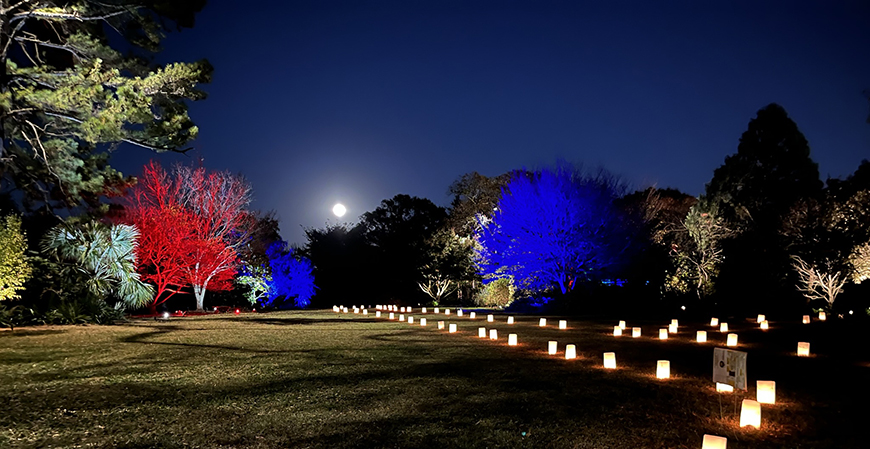
Moonlight Shining Brightly
By Arlene Calhoun, Associate Director
After a two-year hiatus Moonlight in the Garden has returned and secured its place in JC Raulston Arboretum history. Never before has an event attracted so many first-time visitors to the garden. Never before has a single event raised so much money for the Arboretum’s operating budget. And never before has the Arboretum canceled a large public event because of a severe weather threat.
This is the fifth running of Moonlight in the Garden in its current rendition and the numbers are staggering even for those working behind the scenes tweaking the event each year and setting yearly goals. With eight days left before the event ends, the Arboretum collected 20% more revenue than in 2019, the largest earning year yet.
Of the 9,392 tickets sold to date, 77% of the ticket holders are not members of the Arboretum. Many will visit the Arboretum for the first time during this spectacular event. This is music to the ears of everyone who has worked decades to attract visitors to this internationally recognized botanical garden.
Hurricane Nicole secured her place in the JCRA historical annals with the event closing on Friday, November 11, because of the threat of dangerous weather. Forty-eight hours before the gates opened over 1,493 ticket holders were notified of the closing and given the option to choose another night. Twenty-four hours later over 1,100 ticket holders were all set to attend another evening. Impressive.
Moonlight in the Garden can not be mentioned without thanking the village of people who work tirelessly on this annual fundraiser. From John Garner and his amazing team at Southern Lights of Raleigh to the JCRA volunteers and the hundreds of volunteer hours that will accumulate before the event ends. This includes an extra loud thank you to the amazing and dedicated Arboretum staff who willingly do what needs to be done to ensure the event’s success. Moonlight in the Garden has a magical way of bringing people together in the best way possible.
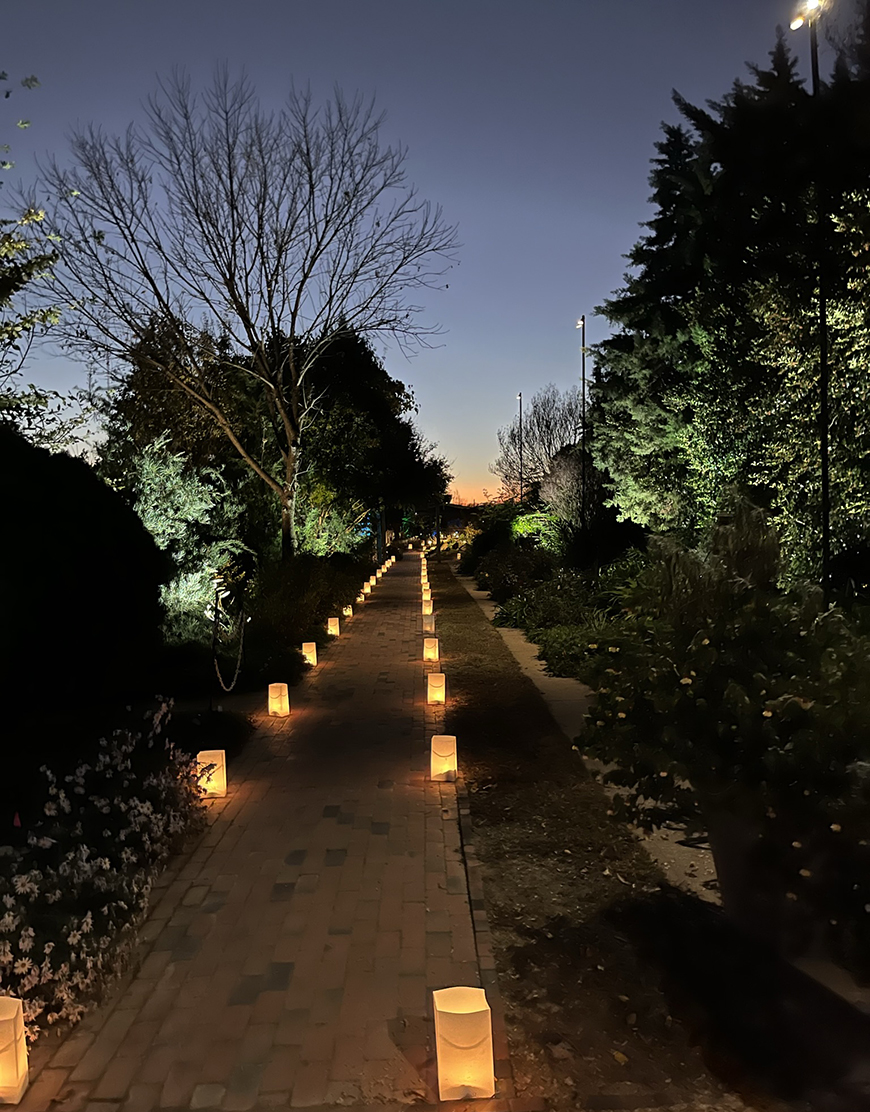

It will be exciting to see what the final numbers bring, until then enjoy the photos from this year’s stellar show.
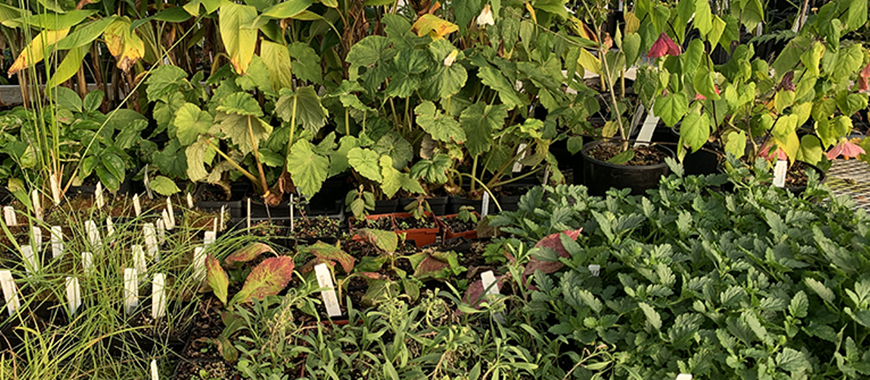
Wishlist
By Mark Weathington, Director
The JCRA’s wish list is a win-win for all of us. You love the amazing selection of plants on our plant buggy, in our sales and auctions, and of course the ones we give away to you each October. We love to grow plants to distribute to you and our peers and partners in the nursery industry and other botanical institutions.
The visible projects like garden arbors and benches often capture the most attention when we send out our wishlist but those items you don’t often see are just as important for us to function. Sorely needed new hoop houses and nursery benches are necessary to grow all the plants you love, especially the ones we propagate from the JCRA collections and acquire on research expeditions.
Your gift of any size equips us to achieve the Arboretum mission of research, outreach, and community engagement not just today but also for years to come. We hope you will consider us in your giving plans: go.ncsu.edu/giveJCRAspecialprojects.
For more information, please contact Amy Beitzel at amy_beitzel@ncsu.edu or (919) 515-1680.
Arboretum Updates
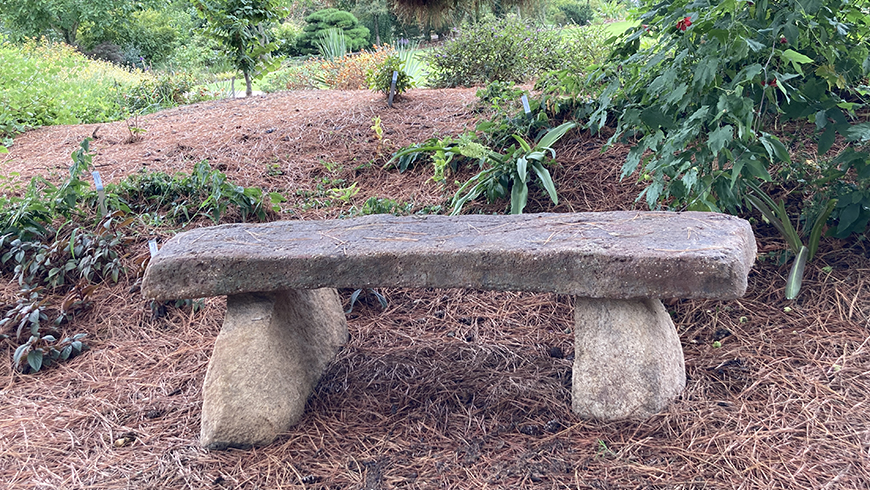
Artistry in Stone
By Joy E. Burns, School Program Coordinator
The JC Raulston Arboretum is pleased to announce a new collection of sculptures now on display by local artist, Phil Hathcock. Phil’s relationship with the Arboretum is a long one that includes a family tree of NC State alumni. "The Arboretum has been a passion of mine. Where else can you see so many different types of plants put together in such an artistic way?"
At a very young age Phil was fascinated by the natural world. As a young man he began exploring landscapes throughout the Southeast and Asia. This led to the founding of Blue Ridge Stone Company and a landscape design company, both of which were stepping stones to a career in stone sculpture. Because of Phil's respect and appreciation for nature he strives to preserve the natural beauty in each sculpture. Each piece is thoughtfully placed in the garden, to not only provide the best view of the sculpture, but also elevate the garden’s aesthetic as a whole.
Only elements and materials that enhance and compliment natural stones are used, such as copper, stainless steel, glass and wood. These sculptures are a result of combining, balancing and sculpting stones of amazing size and proportion.
Pieces will be on display at the JC Raulston Arboretum through most of 2023 and several of his stone benches may become permanent features as memorials or naming opportunities. Phil’s work has been exhibited widely in universities, galleries and numerous public and private arenas in the cities of Cary, Pinehurst and Wilmington, NC, Charlottesville, VA, and North Charleston, SC. See more at philhathcock.com.
"I Spy!" Art in the Garden
Placement of Phil Hathcock’s sculptures has provided JCRA with a unique tour experience for its youngest visitors. The Children’s Education department has created an "I Spy!" Tour that features Phil’s sculptures and other artistic elements during a walking tour of the garden.
As kids explore the garden with their tour guide, they discuss the seven basic elements all artists use to create visually pleasing art: line, shape, color, value, form, texture and space. Not surprisingly, by the end of the tour they begin to see the entire garden as a work of art in itself!
"When it comes to nature, the less we do to alter it, the more beauty it will retain." –Phil Hathcock

Young visitors to the garden discuss whether this "tree" is alive or dead and why it is a fitting piece for the garden.
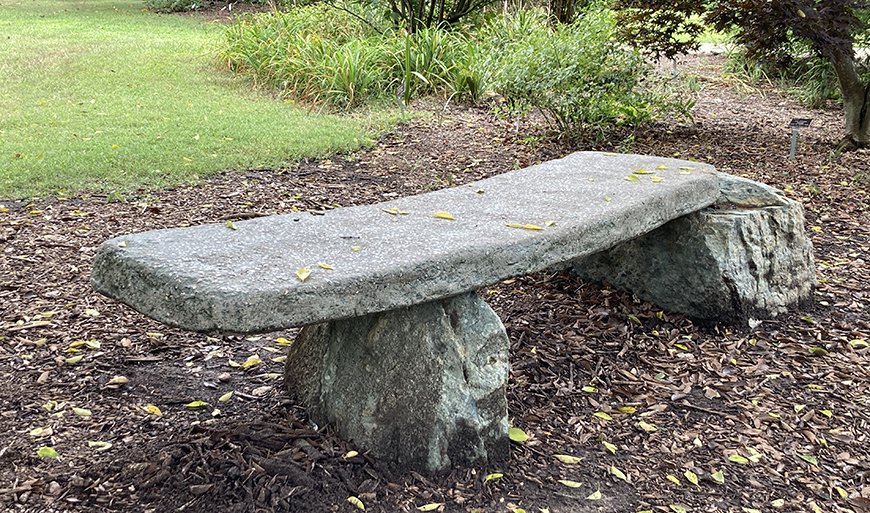
The uprights supporting this bench exhibit a blue-green color as they were rescued from an old copper mine here in the Piedmont. The seat top is a man-made casting; formed by digging a hole in the ground, pouring concrete, and then digging up the slab once it is set. Several of Phil’s benches can be found tucked in the garden—all are perfect for resting and may be available as naming opportunities.
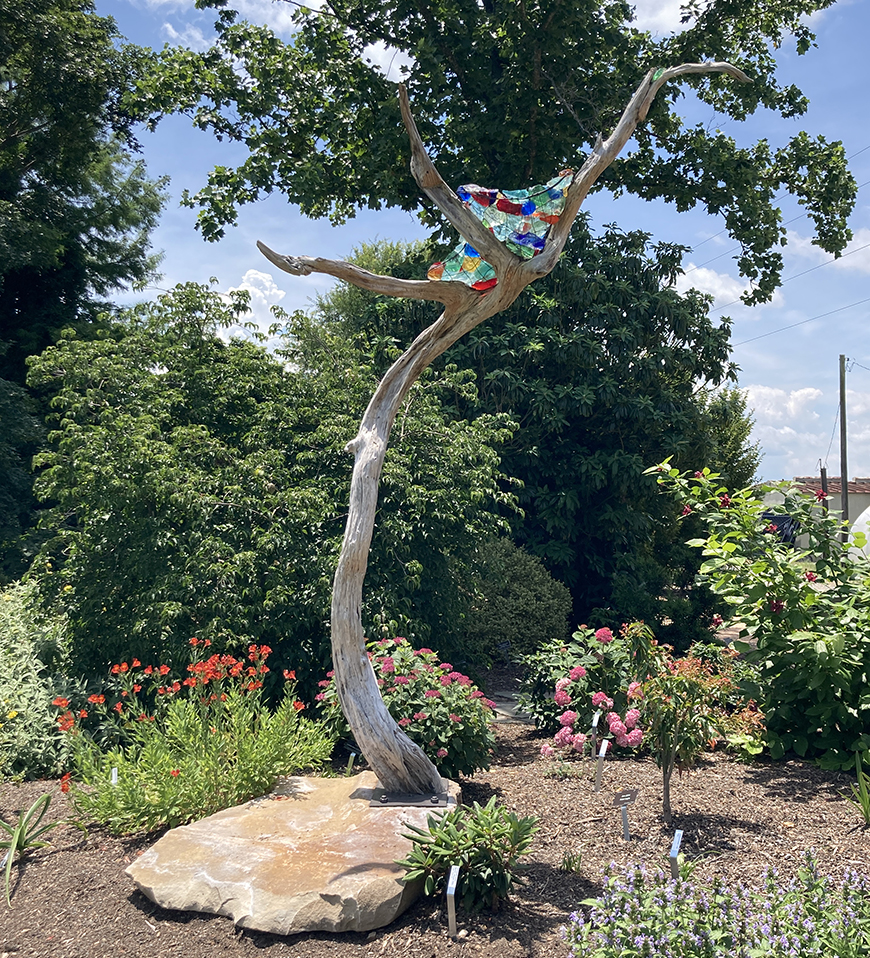
This whimsical sculpture features a piece of petrified heart-sap pine pulled from a river in the Uwharrie mountains in western North Carolina. Colorful hand-picked glass lightly sits in the crook of the tree wrapped up with copper wire. As the sun reflects the stones’ colors, one can see why Phil titled it "Butterfly Tree."
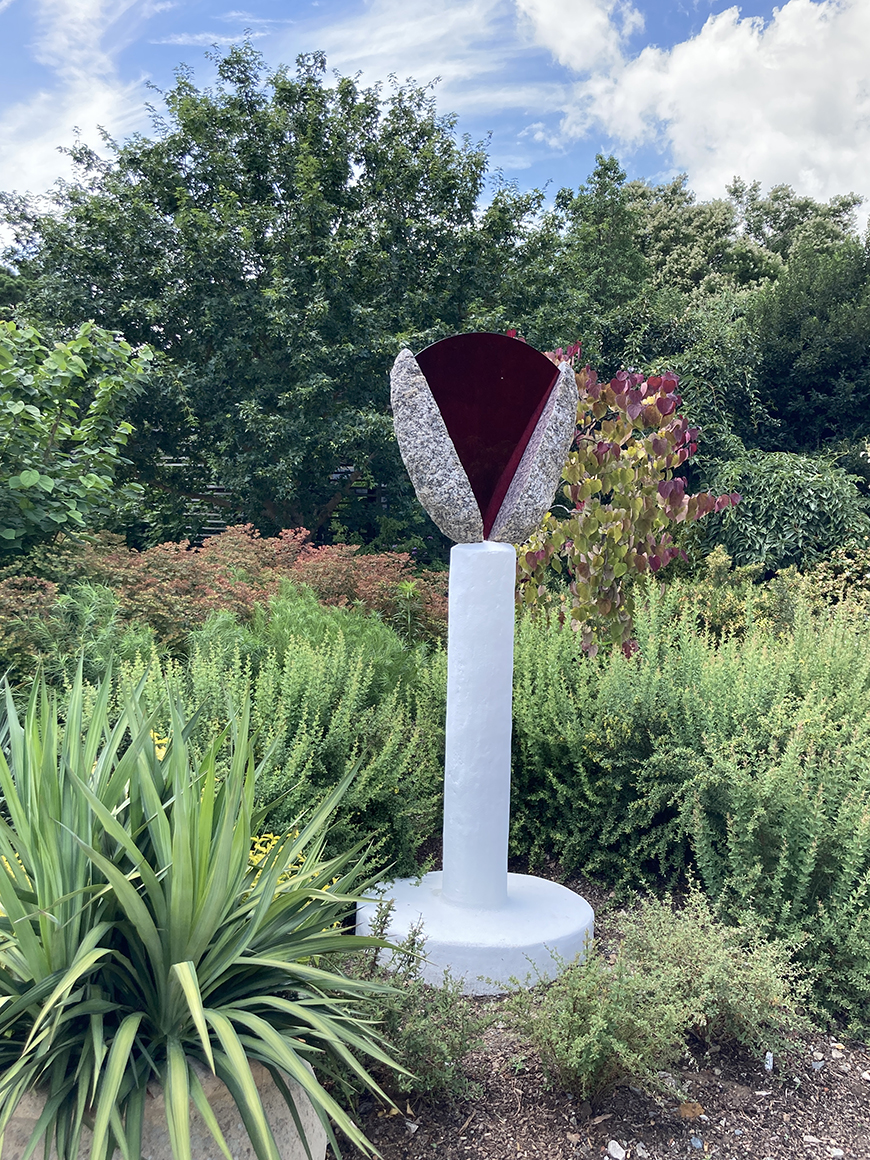
Positioned on the corner of the great lawn, "Due West" was inspired by a photo of a vibrant sunset, as seen from a railroad track. One can immediately see the influence of converging lines in the sculpture. In addition, the deep burgundy color of the glass captures reflections of nearby plants and structures while also casting patterned shadows on the garden path.
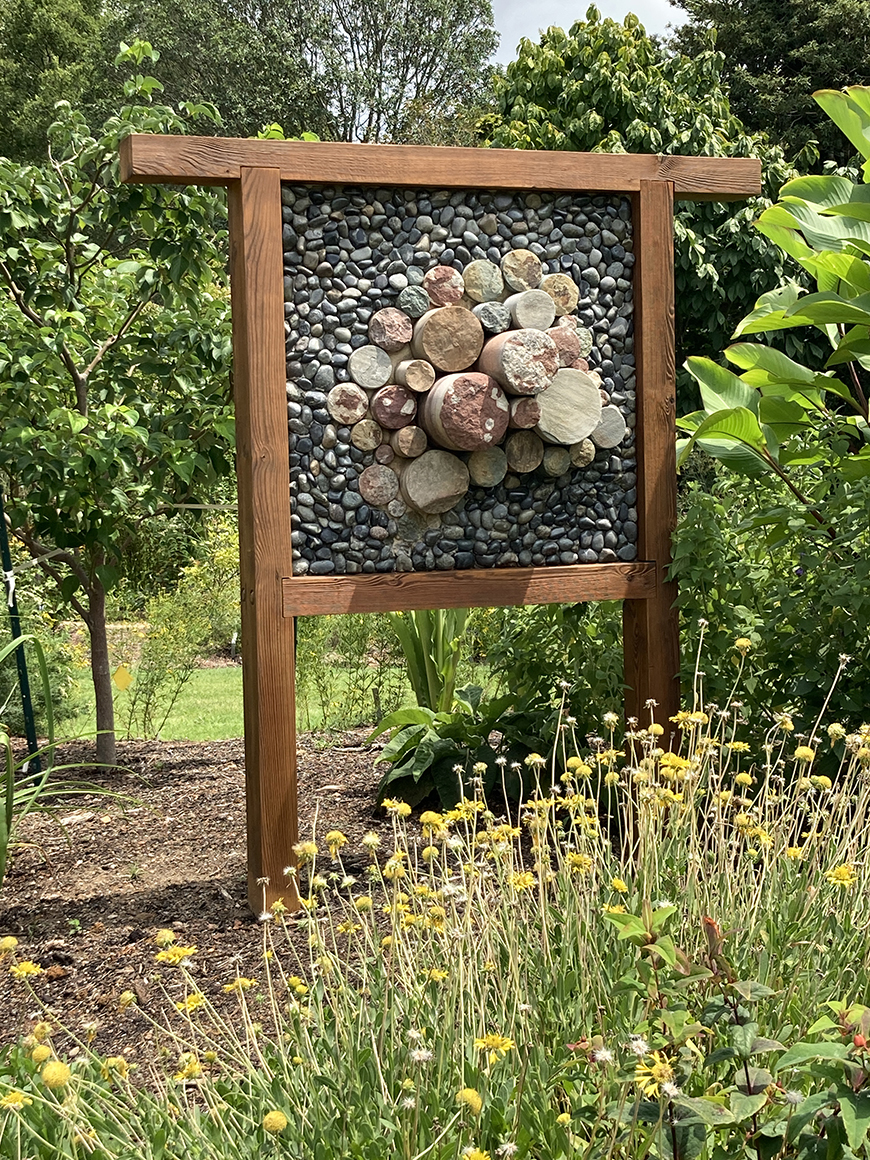
"Core" literally displays pieces of North Carolina—in stone. Cylindrical core samples are a result of drilling into natural substances such as stone, soil or other compacted media—and are often conducted at prospective building sites. Phil’s use of core samples in his art reveals the interior colors and textures of stones from across the state.
Membership
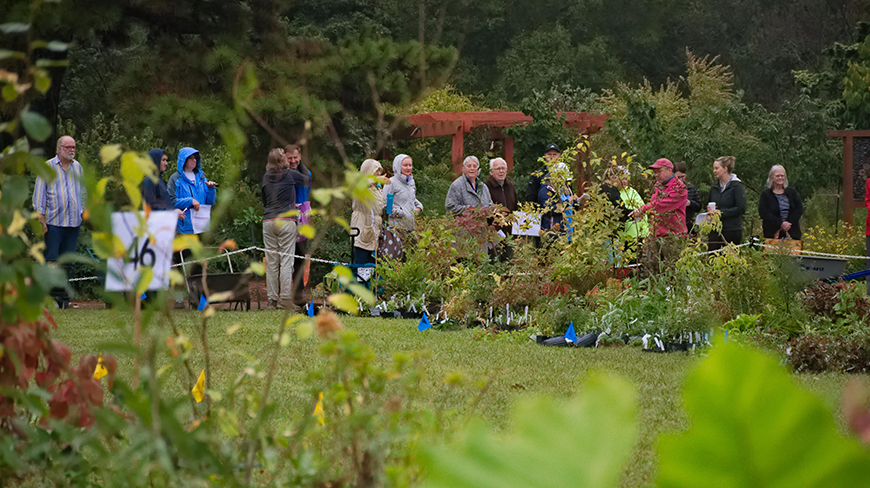
Grounded in our Mission
By Arlene Calhoun, Associate Director
The Arboretum membership now spans across 28 states and Belgium and our education programming reaches 32 states and the United Kingdom. Enthusiasm for plants and knowledge keeps us motivated to share what we know and what we’re learning.
Access is important to us. The Arboretum is admission free and open to everyone thanks to an active membership and dedicated supporters. Our plant buggy offers access to unique plants propagated from our collection to everyone who visits. Our free online educational programs give access to plant-lovers on a variety of topics no matter where they call home, and an Arboretum membership opens the door even further with regular updates and news from the Arboretum and access to free plants and seeds propagated and collected by interns and volunteers from our internationally renowned collection. Access is key and connecting people with plants is our priority.
I’d venture to say, access is our number one-member benefit—access to register first for popular educational programming; priority access to register your up-and-coming gardeners into our wonderful summer camps and access to a community of fellow plant-people, their experiences, and perhaps a plant or two from their personal gardens. Our community is thriving.
The membership program at the JC Raulston Arboretum is robust, mission-driven, and rooted in longtime traditions. Our members are devoted friends, lifelong learners, and passionate about plants, all they offer, and problems they solve. The Arboretum’s dedication to fulfill the mission to diversify the landscapes in the Southeast, set by our founder, J. C. Raulston, and to connect people with plants is as strong as ever and deeply rooted in our organization and membership program. Generosity is our nature, and we regularly look for ways to keep our members updated and engaged.
The response to our first annual online rare seed distribution was tremendous and we are looking forward to implementing the next new benefit available to our new Explorer membership level ($150) and above. For these qualifying membership levels, members choose between two ways to participate in our Annual Plant Giveaway. Members can preselect six plants from a curated online catalog in September or come the first Saturday in October and participate in the longtime Arboretum tradition and select plants in person. We share your enthusiasm for the Plant Giveaway and are excited to find a way to offer plants to those who can’t join us personally.
Moonlight in the Garden returned under a full moon this November with added member benefits. Members enjoyed first access to buy tickets. And took advantage of the new Anytime tickets, available only to Arboretum members. These tickets take some of the guesswork out of which night works best and makes gifting Moonlight in the Garden tickets a bit easier. They allow entry for any general admission night, any time slot. (They cannot be used for our Preview Night.)
This year our gates opened 30 minutes early on Preview Night for Arboretum members giving them early access to hot cider, marshmallows, a glass of wine or beer and a delicious fall spread provided by Rocky Top Catering before the gates opened to everyone else.
We thank our members for the continued support and enthusiastic approach to horticulture. We are one of the most respected research gardens in the nation and we strive to stay on mission and relevant for our members and the professional community we serve.
Volunteering
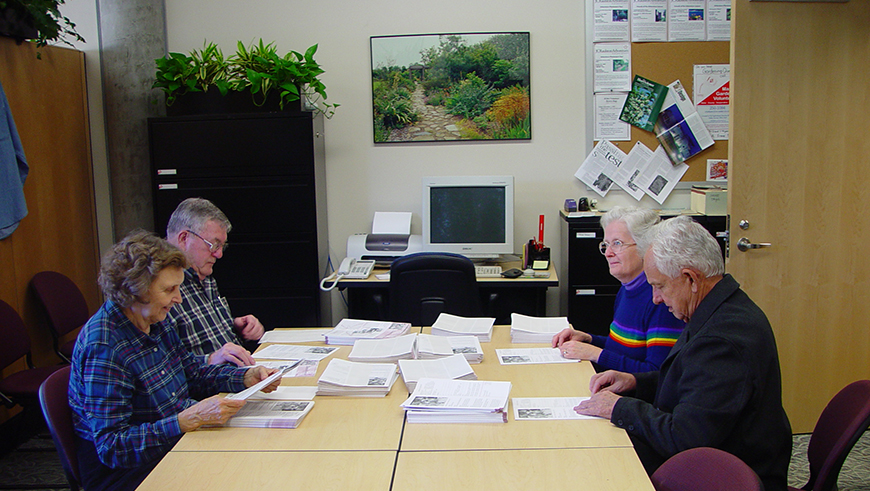
In Memory of Bobby Gene Wilder, 1932 – 2022
Bobby Wilder was an avid volunteer for more than 30 years and was always on the front row of every lecture held at JCRA. He was always the first to offer a sponsorship, buy a new computer, or donate whatever was needed. Bobby created several endowments supporting horticultural scholarships and internships. He left a substantial legacy gift to the JCRA’s Endowment for Excellence. The Bobby Wilder Visitor Center was named for him as a tribute to his long-time service and support.
Remembrances
Kathryn Wall:
I met Bobby Wilder soon after I got the job of membership and volunteer coordinator. He was always willing to help me and did a lot of data entry of volunteer hours or stuffing large mailings. I always delight when several volunteers who don’t know each other enjoy each other’s company, and if I knew if I could find a volunteer who liked to travel, they would work well with Bobby and the time would pass quickly despite the tedious administrative work.
One year at Raulston Blooms, Bobby was taking money for onsite tickets. I realized I had the perfect opportunity to snap his photo in front of the sign at the Visitor Center bearing his name, and I got my favorite photo of him. He was smiling and was so happy when the other volunteers realized his celebrity that day!
Bobby was a longtime volunteer, and my oldest record has him doing data entry. He had over 2,300 volunteer hours recorded in our system, but countless more no doubt in his advocacy and generosity in promoting and supporting the JCRA.
Mark Weathington:
I remember the first time I met Bobby Wilder. It was at my interview for the assistant director position on April 16, 2007, where he grilled me during an opportunity for Arboretum members to participate in the hiring process. In the intervening years we traveled together on several occasions—I remember a lovely lunch with Bobby and Dan Hinkey in Washington, my first visit to my horticultural hero Roy Lancaster’s garden, and a trek to the Cape of Good Hope. In 2014 when I threw my hat in the ring for my current position, Bobby was there front and center to grill me again to make sure I was up to the task.
He was dedicated to the JCRA as a volunteer for decades, as a donor, and as a source of inspiration for those of us who got to know him. Bobby lived a full life, he found the love of his life, Jack Lamm, traveled all over the globe including an epic and legendary journey around Europe—I wish I could hear some of those stories again—and supporting causes he was passionate about. Bobby will forever be connected to the Arboretum that he helped build through the legacy of the Bobby G. Wilder Visitor Center and his influence in ways big and small over the years. More importantly Bobby will be remembered by those of us he inspired to live a full life by following our passions and providing positive impacts to help make the world a little bit better.

Upcoming Events
January Events, Programs, and Sales
February Events, Programs, and Sales
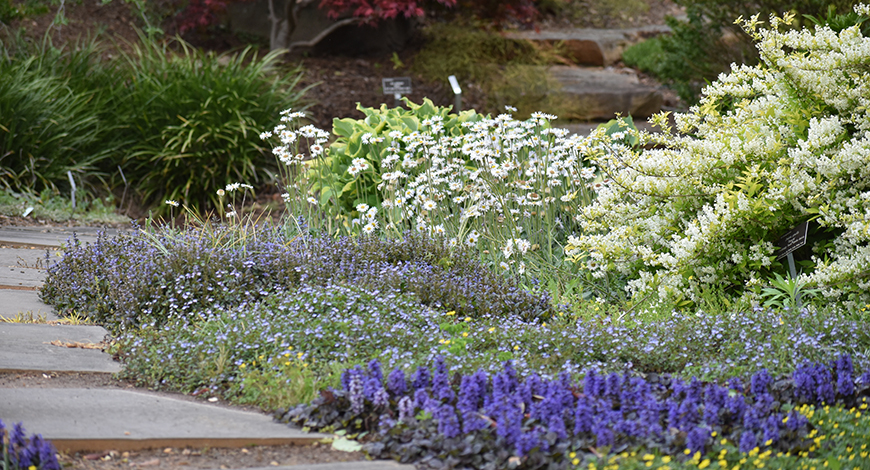
Winter Symposium
"Tossing the Turf"
Saturday, February 18, 2023
9:00 am to 12:00 pm
Featuring:
- Dr. Mike Richardson, University of Arkansas, Pollinator Friendly Lawns
- Preston Montague, Reducing Lawns through Deliberate Design
- Mark Weathington, Flamboyant Flowering Lawns
For green industry professionals:
Save the Date
Piedmont Prairies Program
Friday, February 17, 2023
1:30 pm to 4:30 pm
Presentations by Sarah P Duke Gardens and
Greg Paige, JC Raulston Arboretum
Limited openings available.
CEU's applied for.
More details & registration online at jcra.ncsu.edu.
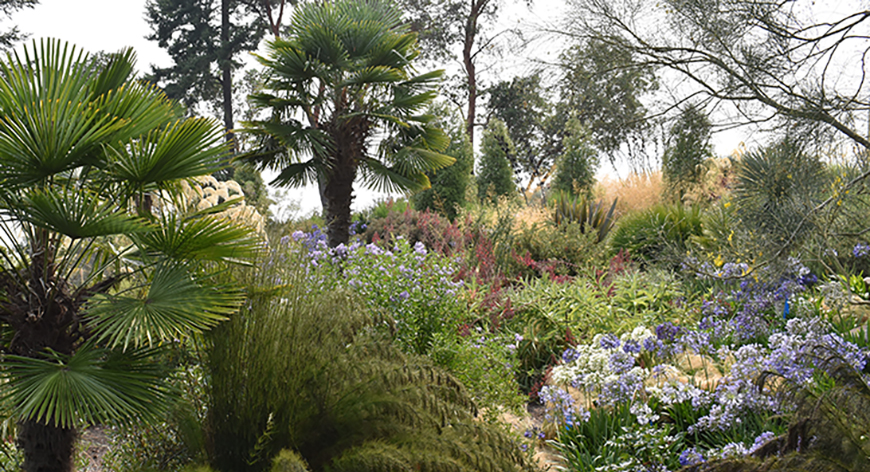
Southeastern Plant Symposium
& Rare Plant Auction
In Person & Online
Hosted by JC Raulston Arboretum and Juniper Level Botanic Garden
June 16 & 17, 2023
Mark your calendars now for the premiere plant event of the year.
Featuring a who’s who in horticulture including:
- Richard Olsen PhD – Director, U.S. National Arboretum
- Nina Bassuk PhD – Emeritus Professor, Cornell University
- Scott McMahan – Manager, International Plant Exploration, Atlanta Botanic Garden
- Sue Milliken & Kelly Dodson – Far Reaches Botanical Conservancy
- And many more.
The program will be held in person and streamed online and don’t forget the world’s greatest rare plant auction. We’ve already begun assembling a veritable smorgasbord of amazing plants from around the world. Rare conifers, hardy orchids, strange cultivars—there should be something for even the most jaded plant lover.
See you in June!
Credits
Friends of the JC Raulston Arboretum Newsletter
Winter 2022 – Vol. 25, No. 2
Kathryn Wall, Editor
kbwall@ncsu.edu
Photographs by Tim Alderton, Joy Burns, Paul Field, Christopher Todd Glenn, Marc Hall, Jimmy Sumerell, Ira Tucker, unknown, Kathryn Wall, Mark Weathington, and Jeanne Wilkinson.
© December 2022 JC Raulston Arboretum
JC Raulston Arboretum
NC State University Campus Box 7522
Raleigh, NC 27695-7522
4415 Beryl Road
Raleigh, NC 27606-1457
Phone: (919) 515-3132
Fax: (919) 515-5361
jcra.ncsu.edu
facebook.com/jcraulstonarboretum/
jcraulstonarboretum.wordpress.com
youtube.com/jcraulstonarb/
instagram.com/jcraulstonarboretum/
Staff
Mark Weathington, Director
Arlene Calhoun, Associate Director
Tim Alderton, Research Technician
Amy Beitzel, Development Assistant
Joy Burns, School Program Coordinator
Dennis Carey, Curator
Bernadette Clark, Bedding Plant Trials Coordinator
Kathy Field, Business Services Coordinator
John Flye, Development Assistant
Sophia McCusker, Nursery and Research Technician
Elizabeth Overcash, Children’s Program Coordinator
Greg Paige, Director of Horticulture
Amanda Pattillo-Lunt, Rental Coordinator
Alycia Thornton, Director of Development
Kathryn Wall, Membership and Volunteer Manager
Blake Wentley, Education Assistant
Board of Advisors
Melanie Kelley, Chair
Rob Thornton, 1st Vice Chair
Heather Rollins, 2nd Vice Chair
Kathie Kalmowitz, Ph.D., Past Chair
Jeanne Andrus
Robert Bartlett, Jr.
Sylvia Blankenship, Ph.D.
Basil Camu
Cyndy Cromwell
Dale Deppe
Sandra Dutton
Cindy Green, Ph.D.
David Hoffman
Mike Hudson
Rick Lawhun
Carol McNeel
Jeana Myers, Ph.D.
Frank Louws, Ph.D., Ex-officio
Tom Skolnicki, Ex-officio
Alycia Thornton, Manager
Cover: Ardisia japonica cultivars by Tim Alderton
